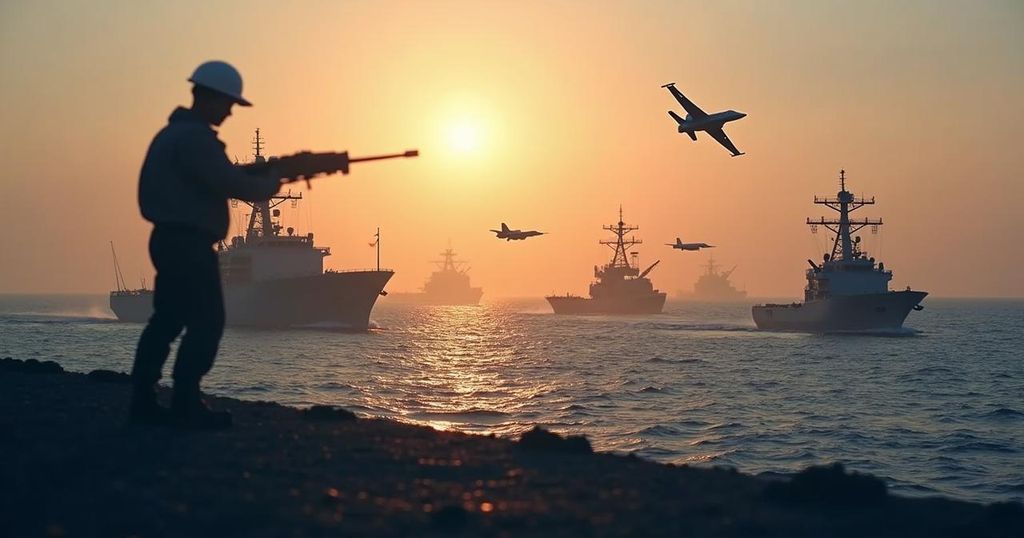US and China Conduct Competing Military Exercises in the South China Sea
China’s military exercises in the South China Sea coincided with U.S. naval drills involving key allies. The U.S. Seventh Fleet operated within the Philippine EEZ, emphasizing cooperation against China’s assertive territorial claims. Philippine officials disputed claims of Chinese drills near Scarborough Shoal, indicating potential internal propaganda motives. The dynamics contribute to heightened tensions surrounding sovereignty issues and regional security efforts.
In a demonstration of competing military capabilities, China conducted military exercises in the contested South China Sea, specifically near the contentious Scarborough Shoal, coinciding with naval drills executed by the United States Seventh Fleet in partnership with regional allies. The exercises conducted by the Seventh Fleet on Saturday included participation from naval forces of the Philippines, Japan, Australia, and New Zealand, taking place within the Philippines’ internationally recognized exclusive economic zone (EEZ). In parallel, China’s Southern Command Theater Command reported executing reconnaissance, air and sea patrols, and routine military drills nearby Huangyan Island, which is perceived by China as part of its indisputable sovereignty. While China asserted that “some countries outside the region have disrupted the South China Sea and created regional instability,” the Philippines’ military authorities contested the claim of Chinese drills occurring near the disputed shoal, suggesting that such announcements might be part of China’s internal propaganda strategy. Additionally, Scarborough Shoal is located approximately 100 miles from Luzon, a crucial island for the Philippines and rightfully part of its EEZ under international maritime law, which grants the nation the exclusive right to natural resources within a 200 nautical mile radius of its coastline. The U.S. Seventh Fleet’s exercises, known as the maritime cooperative activity, involved various operations such as deck landings and search-and-rescue maneuvers and included prominent naval assets from participating nations. Vice Admiral Fred Kacher emphasized the significance of the event as a multifaceted opportunity to enhance joint operational skills while asserting commitment to maintaining a free and open Indo-Pacific region. These coordinated military activities are seen as a response to China’s assertive territorial claims, which conflict with the interests of several Southeast Asian nations, including the Philippines, Vietnam, and Brunei. Moreover, the concurrent exercises reported by the Seventh Fleet followed the passage of Japanese naval vessels through the Taiwan Strait, marking increased military cooperation among the nations involved and signaling a unified front against China’s growing influence in the region.
The South China Sea has been a longstanding point of contention, with multiple nations laying claim to various islands and features within the sea. China has been particularly assertive, proclaiming sovereignty over vast areas of the South China Sea, including those traditionally utilized by other countries for fishing and exploration. The region is essential not only for its resources but also for strategic shipping lanes. This ongoing dispute involves intricate geopolitical dynamics, particularly among China, the Philippines, Vietnam, and other Southeast Asian nations. Recent military activities by both China and the United States showcase the rising tensions and the global implications of territorial assertions in these waters.
In summary, the simultaneous military exercises conducted by China and the United States, along with allied nations, underscore the escalating tensions in the South China Sea. While China asserts its territorial claims, regional allies reinforce their collaborative defense strategies to counteract Beijing’s assertiveness. The activities illustrate a broader commitment by the United States and its partners to uphold international maritime laws while navigating the complexity of regional disputes. The situation remains fluid, with ongoing military developments likely to influence future geopolitical relations in the area.
Original Source: www.newsweek.com








Post Comment